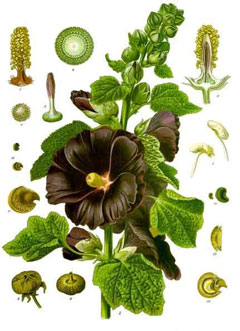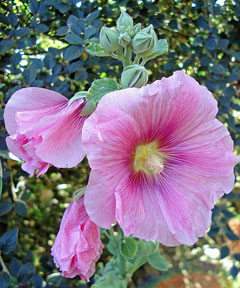 |
|
http://commons.wikimedia.org/wiki/File:Koeh-009.jpg |
 |
| http://commons.wikimedia.org/wiki/User:K!roman |
Translate this page:
Summary
Bloom Color: Lavender, Orange, Pink, Purple, Red, Salmon, White, Yellow.
Main Bloom Time: Early summer, Early fall, Late summer, Late fall, Mid summer, Mid fall. Form: Upright or erect.
Physical Characteristics

 Alcea rosea is a PERENNIAL growing to 2.4 m (7ft) by 0.6 m (2ft in) at a fast rate.
Alcea rosea is a PERENNIAL growing to 2.4 m (7ft) by 0.6 m (2ft in) at a fast rate.
See above for USDA hardiness. It is hardy to UK zone 6 and is not frost tender. It is in flower from July to September, and the seeds ripen from August to October. The species is hermaphrodite (has both male and female organs).
Suitable for: light (sandy), medium (loamy) and heavy (clay) soils. Suitable pH: mildly acid, neutral and basic (mildly alkaline) soils. It cannot grow in the shade. It prefers dry or moist soil.
UK Hardiness Map
US Hardiness Map
Synonyms
Althaea rosea.
Plant Habitats
Woodland Garden Sunny Edge; Dappled Shade; Cultivated Beds;
Edible Uses
Edible Parts: Flowers Leaves Oil Root Stem
Edible Uses: Oil Tea
Young leaves - raw or cooked[2, 55, 177]. A mild flavour, but the texture leaves something to be desired[K]. They have been used as a pot-herb, though they are not particularly palatable[4]. They can also be chopped up finely and added to salads[K]. Inner portion of young stems - raw[101]. Flower petals and flower buds - raw. Added to salads[183]. A nutritious starch is obtained from the root[183]. A refreshing tea is made from the flower petals[183].
References More on Edible Uses
Medicinal Uses
Plants For A Future can not take any responsibility for any adverse effects from the use of plants. Always seek advice from a professional before using a plant medicinally.
Antiinflammatory Astringent Demulcent Diuretic Dysentery Emollient Febrifuge
The flowers are demulcent, diuretic and emollient[4, 21]. They are useful in the treatment of chest complaints[4], and a decoction is used to improve blood circulation, for the treatment of constipation, dysmenorrhoea, haemorrhage etc[218]. The flowers are harvested when they are open and are dried for later use[238]. The shoots are used to ease a difficult labour[218]. The root is astringent and demulcent[240]. It is crushed and applied as a poultice to ulcers[218]. Internally, it is used in the treatment of dysentery[240]. The roots and the flowers are used in Tibetan medicine, where they are said to have a sweet, acrid taste and a neutral potency[241]. They are used in the treatment of inflammations of the kidneys/womb, vaginal/seminal discharge, and the roots on their own are used to treat loss of appetite[241]. The seed is demulcent, diuretic and febrifuge[240].
References More on Medicinal Uses
The Bookshop: Edible Plant Books
Our Latest books on Perennial Plants For Food Forests and Permaculture Gardens in paperback or digital formats.

Edible Tropical Plants
Food Forest Plants for Hotter Conditions: 250+ Plants For Tropical Food Forests & Permaculture Gardens.
More

Edible Temperate Plants
Plants for Your Food Forest: 500 Plants for Temperate Food Forests & Permaculture Gardens.
More

More Books
PFAF have eight books available in paperback and digital formats. Browse the shop for more information.
Shop Now
Other Uses
Compost Dye Litmus Oil Paper
A fibre obtained from the stems is used in papermaking[189]. The fibres are about 1.9mm long. The stems are harvested in late summer, the leaves are removed and the stems are steamed until the fibres can be removed. The fibres are cooked with lye for 2 hours and then ball milled for 3 hours or pounded with mallets. The paper is light tan in colour[189]. The flowers are an alternative ingredient of 'Quick Return' herbal compost activator[32]. This is a dried and powdered mixture of several herbs that can be added to a compost heap in order to speed up bacterial activity and thus shorten the time needed to make the compost[K]. The seed contains 12% of a drying oil[114, 240]. The red anthocyanin constituent of the flowers is used as a litmus[114]. A brown dye is obtained from the petals[168].
Special Uses
Food Forest
References More on Other Uses
Cultivation details
Landscape Uses:Border, Container, Foundation, Specimen. Succeeds in most soils[1]. Poor soils should be enriched with organic matter[1, 111]. Prefers a heavy rich soil and a sheltered sunny position[200]. Plants are hardy to about -15°c[200]. A very ornamental plant, it is usually grown as a biennial due to its susceptibility to the fungal disease 'rust'[1, 200]. There are many named varieties[238]. Young plants, and also the young growth in spring, are very attractive to slugs[K]. Special Features:Attracts birds, Attracts butterflies, Suitable for cut flowers, Attractive flowers or blooms. The plant is heat tolerant in zones 10 through 3. (Plant Hardiness Zones show how well plants withstand cold winter temperatures.
Plant Heat Zones show when plants would start suffering from the heat.
The Plant Heat Zone map is based on the number of "heat days" experienced in a given area where the temperature climbs to over 86 degrees F (30°C).
At this temperature, many plants begin to suffer physiological damage. Heat Zones range from 1 (no heat days) to 12 (210 or more heat days).
For example Heat Zone. 11-1 indicates that the plant is heat tolerant in zones 11 through 1.) For polyculture design as well as the above-ground architecture (form - tree, shrub etc. and size shown above) information on the habit and root pattern is also useful and given here if available. The plant growth habit is a clumper with limited spread [1-2].
References Carbon Farming Information and Carbon Sequestration Information
Temperature Converter
Type a value in the Celsius field to convert the value to Fahrenheit:
Fahrenheit:
The PFAF Bookshop
Plants For A Future have a number of books available in paperback and digital form. Book titles include Edible Plants, Edible Perennials, Edible Trees,Edible Shrubs, Woodland Gardening, and Temperate Food Forest Plants. Our new book is Food Forest Plants For Hotter Conditions (Tropical and Sub-Tropical).
Shop Now
Plant Propagation
Seed - sow April/May or August/September in pots or in situ[200, 238]. Easily grown from seed, which usually germinates in about 2 - 3 weeks at 20°c[133, 268]. When large enough to handle, prick the seedlings out into individual pots and plant them out in the summer. Division after flowering. Only use rust-free specimens. Root cuttings in December. Basal cuttings at almost any time of year.
Other Names
If available other names are mentioned here
Native Range
TEMPERATE ASIA: Turkey. EUROPE: Turkey,
Weed Potential
Right plant wrong place. We are currently updating this section.
Please note that a plant may be invasive in one area but may not in your area so it's worth checking.
Conservation Status
IUCN Red List of Threatened Plants Status :

Growth: S = slow M = medium F = fast. Soil: L = light (sandy) M = medium H = heavy (clay). pH: A = acid N = neutral B = basic (alkaline). Shade: F = full shade S = semi-shade N = no shade. Moisture: D = dry M = Moist We = wet Wa = water.
Now available:
Food Forest Plants for Mediterranean Conditions
350+ Perennial Plants For Mediterranean and Drier Food Forests and Permaculture Gardens.
[Paperback and eBook]
This is the third in Plants For A Future's series of plant guides for food forests tailored to
specific climate zones. Following volumes on temperate and tropical ecosystems, this book focuses
on species suited to Mediterranean conditions—regions with hot, dry summers and cool, wet winters,
often facing the added challenge of climate change.
Read More
Expert comment
Author
L.
Botanical References
100200
Links / References
For a list of references used on this page please go here
Readers comment